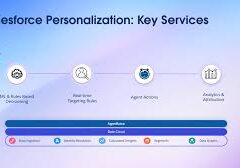Most workers today recognize the importance of rich data analytics in their jobs. However, 33% struggle to understand and generate insights from data. To address this, Salesforce has introduced Einstein Copilot for Tableau, which allows users of all skill levels to create complex data visualizations without extensive learning or coding. Democratize Data with Einstein Copilot for Tableau.
Launched in April 2024, the beta version of this AI assistant features a user-friendly interface that simplifies the process with questions or simple commands. This facilitates the quick creation of comprehensive data presentations, including reports, dashboards, and various charts.
Democratize Data with Einstein Copilot for Tableau
Einstein Copilot for Tableau leverages a combination of AI technologies—natural language processing (NLP), machine learning (ML), and generative AI—to provide actionable insights. NLP enables conversational and intuitive interactions, while ML models process user queries and analyze data. Generative AI drives cognitive reasoning, planning, and creates insights, recommendations, and diagrams based on user inputs.
By integrating with Tableau Cloud, Einstein Copilot accesses historical proprietary data, enables advanced data analysis, and translates user intent into actionable insights. It relies on Tableau’s analytics infrastructure to execute code and displays results through user-friendly visualizations and dashboards.
Additionally, the Einstein Trust Layer secures and protects private data in Einstein Copilot. It authorizes inbound requests, ensuring users have necessary permissions to access specific data and safeguards model outputs to prevent the disclosure of confidential information.
How Einstein Copilot for Tableau Transforms Requests into Insights
To understand how Einstein Copilot for Tableau turns requests into actionable insights, let’s walk through each step of the interaction process:
- Query Formulation: Einstein Copilot for Tableau generates automated query suggestions based on user profiles, historical data interactions, roles, and dataset access. This streamlines data exploration by anticipating potential questions. Users can select from suggested questions or choose their own.
- Intent Detection: Once users enter their questions, Einstein Copilot’s intent detection system anticipates what users want to achieve, leveraging training on a variety of intents.
- Code Translation: The code interpreter, powered by ML models, translates questions into Tableau’s internal programming language to interact with data in Tableau Cloud. This acts as a meta-language, enabling users to communicate requirements without needing to know the underlying coding language.
- Code Validation: The generated code undergoes meticulous validation to ensure correctness and efficiency, checking for errors or issues that could influence the desired outcome.
- Execution and Visualization: After successful validation, the code is executed, and results are transmitted to Tableau Cloud. Tableau’s data modeling and visualization platform then converts the data into visually appealing diagrams or charts for easy interpretation and analysis.
Einstein Copilot for Tableau democratizes access to data analytics, enabling all users to harness the power of data without needing extensive technical knowledge.













